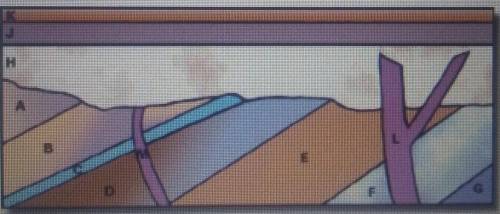
Biology, 30.11.2020 22:50, radaishasmithoxngbj
After examining the picture, which of the following formations is most likely the oldest?
Bed B
Bed D
D-i-k-e M
Bed C


Answers: 1
Other questions on the subject: Biology

Biology, 21.06.2019 13:30, cmariecarrizales
One function of the poly-a tail on eukaryotic mrna sequences is to the mrna be transported from the nucleus to the cytoplasm. prokaryotic mrna also has a poly-a tail. choose the best explanation of the prokaryotic poly-a tail. a. prokaryotic poly-a tails have the same functions as eukaryotic poly-a tails, because this process is highly conserved throughout different species. b. prokaryotic poly-a tails aren't important, because prokaryotes don't have nuclei. c. prokaryotic poly-a tails have other functions, because prokaryotes don't have nuclei. d. prokaryotic poly-a tails are composed of a different molecular structure compared with eukaryotic poly-a tails.
Answers: 3

Biology, 21.06.2019 17:20, magicalforlife
Whose work is most likely to be part-time and at several locations? а. physical therapistb. sports physicianc nutritionistd group fitness instructor
Answers: 1

Biology, 21.06.2019 20:00, rachelkorkees
The shift of a vehicle's weight around its center of gravity is known as
Answers: 2

Biology, 22.06.2019 01:30, eguilford4438
Scenario 5 1) take 10 red and 10 black beans and place them, mixed, on the table. record the starting phenotype # and frequencies (% of your total population) of your starting population in the table provided (generation 0). 2) act as a predator. “capture” as many organisms as you can until you have reduced the population to three organisms. put them aside. at this point, the predators die. 3) the remaining organisms each produce 2 clonal offspring. multiply your organisms accordingly and allow them to mix on the table. calculate and record the resultant phenotype # and frequencies (% of your total population) of your population in the table provided (generation 1). 4) repeat the reproduction event, allowing each of your organisms to produce 2 clonal offspring. calculate and record the resultant phenotype # and frequencies (% of your total population) of your population in the table provided (generation 2). 5) repeat the reproduction event, allowing each of your organisms to produce 2 clonal offspring. calculate and record the resultant phenotype # and frequencies (% of your total population) of your population in the table provided (generation 3).
Answers: 1
Do you know the correct answer?
After examining the picture, which of the following formations is most likely the oldest?
Bed B
Questions in other subjects:

Mathematics, 26.05.2020 13:57

Mathematics, 26.05.2020 13:57

Mathematics, 26.05.2020 13:57


Mathematics, 26.05.2020 13:57


Mathematics, 26.05.2020 13:57

Physics, 26.05.2020 13:57








